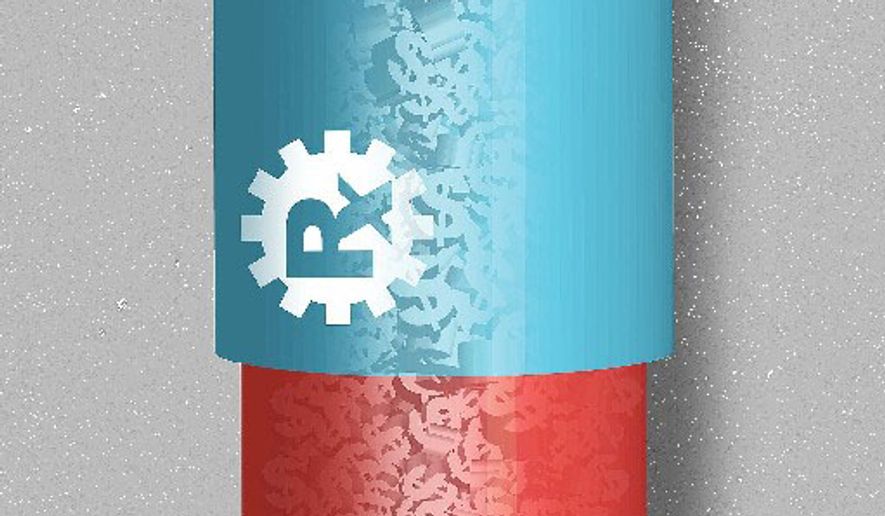OPINION:
President Trump claims he’s preparing an executive order on drug prices.
“For years and years other nations pay less for drugs than we do,” remarked the president. “We’re working on a favored nations clause, where we pay whatever the lowest nation’s price is. Why should other nations — like Canada — why should other nations pay less than us?”
The president’s proposal might seem appealing, but it’s really just another excuse to enact government price controls. That means more red tape, and more headaches for patients.
Price controls are the wrong approach; they will stunt drug innovation and restrict patient access to new cures.
Drug development is risky. Consider that less than 12 percent of experimental drugs make it to market. When all is said and done, it takes more than $2 billion worth of investment and up to 15 years to create just one new drug.
To feel comfortable throwing money toward drug projects — particularly for new and rare diseases — investors need to know they’ll have some possibility of recouping upfront costs and, in the right market, make a profit.
America’s relatively free-market system provides investors this security. Knowing they can make a profit, companies are eager to introduce new products and investment within U.S. borders.
Consider that three-quarters of global pharmaceutical capital investments go to American innovators, where 4,000 medicines are currently in the development pipeline. That’s more than half of all cures in development worldwide.
As a result, 87 percent of all medicines released since 2011 are available in the U.S. market. Patients in price control-ridden nations aren’t so lucky. Just 67 percent of new therapies were made available to U.K. patients during that same time period. And in Canada? Just 48 percent.
American patients are living longer and healthier lives as a result of our robust innovation ecosystem. On average, American women and men live 2.4 and 4.5 years longer, respectively, today than in 1990.
But price control schemes would smother this progress. If the government gets to arbitrarily cap how much drug innovators can charge for hard-won therapies, there will be little incentive to invest in new cures in the first place.
Europe is a prime example. Before price controls gained popularity in the 1970s, the continent used to produce more than half the world’s new medicines. Today, European companies are responsible for roughly one-third of new treatments globally.
President Trump should be well aware of the pitfalls of socialist drug-pricing schemes. After all, this isn’t the first time he’s floated the idea of foreign price controls.
In October, the Trump administration introduced the “international pricing index” model for Medicare “Part B” — the portion of the program which covers potent drugs administered in doctors’ offices or hospitals.
With this change, the government would tie Part B drug reimbursements to a pre-determined international benchmark. This benchmark would be calculated based on the prices paid in more than a dozen other developed nations — many of which use government price controls to keep prices at bay.
For starters, the international pricing index (IPI) proposal ignores a simple fact: generic drugs, which make up roughly 90 percent of all drugs sold across the country, are cheaper in the United States than they are in Europe and Canada. So Americans are already getting a “fairer shake” at the pharmacy counter than most patients in developed nations.
Indeed, the grass isn’t always greener on the other side.
Moreover, patients suffer when the government gets stingy on drug prices. While 95 percent of new cancer treatments are available to U.S. patients, only 75 percent are an option to patients in the United Kingdom, where a bureaucratic agency, the National Institute for Health and Care Excellence, decides whether or not a drug is worth the price.
Patients in Japan — where the government determines if a drug is cost effective — are even worse off. These patients could access a mere 51 percent of new cancer medicines.
Because of the myriad treatment options available stateside, U.S. cancer deaths have plummeted 26 percent since the 1990s, and patients now have a 41 percent greater chance of living five years past diagnosis.
Price controls — no matter what the president calls them — will stifle medical innovation. That means the next groundbreaking treatment for diseases like Alzheimer’s and diabetes could be out of reach. Price controls also threaten promising treatments already in development — without incentives to continue investment in R&D these experimental drugs could get shelved, or nixed all together.
President Trump is right that our health care system needs reform, but price controls aren’t the solution. Instead of pursuing policies that threaten innovation and patient access, he should go back to the drawing board — this time with the best interest of patients in mind.
• Peter J. Pitts, a former FDA associate commissioner, is president of the Center for Medicine in the Public Interest.




Please read our comment policy before commenting.